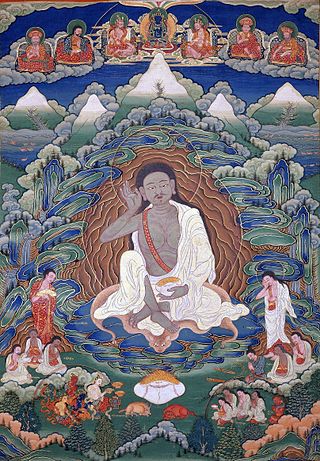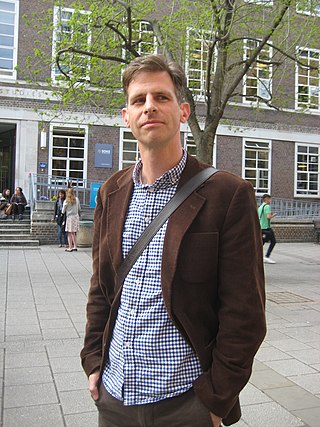Related Research Articles

Tibetan Buddhism is a form of Buddhism practiced in Tibet, Bhutan and Mongolia. It also has a sizable number of adherents in the areas surrounding the Himalayas, including the Nepal India in regions of Ladakh, Sikkim, and Arunachal Pradesh. Smaller groups of practitioners can be found in Central Asia, Xinjiang, Inner Mongolia, and some regions of Russia, such as Tuva, Buryatia, and Kalmykia.

Vajrayāna, also known as Mantrayāna, Mantranāya, Guhyamantrayāna, Tantrayāna, Tantric Buddhism, and Esoteric Buddhism, is a Buddhist tradition of tantric practice that developed in the Indian subcontinent and spread to Tibet, Nepal, other Himalayan states, East Asia, and Mongolia.

Dzogchen, also known as atiyoga, is a tradition of teachings in Indo-Tibetan Buddhism and Bon aimed at discovering and continuing in the ultimate ground of existence. The goal of Dzogchen is knowledge of this basis, this knowledge is called rigpa. There are spiritual practices taught in various Dzogchen systems for awakening rigpa.

Padmasambhava, also known as Guru Rinpoche and the Lotus from Oḍḍiyāna, was a tantric Buddhist Vajra master from medieval India who taught Vajrayana in Tibet. According to some early Tibetan sources like the Testament of Ba, he came to Tibet in the 8th century and helped construct Samye Monastery, the first Buddhist monastery in Tibet. However, little more is known about the actual historical figure other than his ties to Vajrayana and Indian Buddhism.

Bon or Bön, also known as Yungdrung Bon, is the indigenous Tibetan religion which shares many similarities and influences with Tibetan Buddhism. It initially developed in the tenth and eleventh centuries but retains elements from earlier Tibetan religious traditions. Bon is a significant minority religion in Tibet, especially in the east, as well as in the surrounding Himalayan regions.

The Kadam school of Tibetan Buddhism was an 11th century Buddhist tradition founded by the great Bengali master Atiśa (982–1054) and his students like Dromtön (1005–1064), a Tibetan Buddhist lay master. The Kadampa stressed compassion, pure discipline and study.

The Tibetan Buddhist canon is a defined list of sacred texts recognized by various schools of Tibetan Buddhism. The Canon includes the Kangyur, which is the Buddha's recorded teachings, and the Tengyur, which is commentaries by great masters on the Buddha's recorded teachings. The first translation into Tibetan of these manuscripts occurred in the 8th century and is referred to as the Ancient Translation School of the Nyingmas.

Samye, full name Samye Mighur Lhundrub Tsula Khang and Shrine of Unchanging Spontaneous Presence, is the first Tibetan Buddhist and Nyingma monastery built in Tibet, during the reign of King Trisong Deutsen. Shantarakshita began construction around 763, and Tibetan Vajrayana founder Guru Padmasambhava tamed the local spirits for its completion in 779. The first Tibetan monks were ordained there. Samye was destroyed during the Cultural Revolution then rebuilt after 1988.

Nyingma, often referred to as Ngangyur, is the oldest of the four major schools of Tibetan Buddhism. The Nyingma school is founded on the first lineages and translations of Buddhist scriptures from Sanskrit into Tibetan in the eighth century, during the reign of King Trisong Detsen.

Tri Songdetsen was the son of Me Agtsom, the 38th emperor of Tibet. He ruled from AD 755 until 797 or 804. Tri Songdetsen was the second of the Three Dharma Kings of Tibet, playing a pivotal role in the introduction of Buddhism to Tibet and the establishment of the Nyingma or "Ancient" school of Tibetan Buddhism.
Semde (Tibetan: སེམས་སྡེ, Wylie: sems sde; Sanskrit: cittavarga, "mind division", "mind class" or "mind series" is the name of one of three scriptural and lineage divisions within the Dzogchen tradition. The Nyingma school of Tibetan Buddhism traditionally classifies its Dzogchen teaching into three main divisions: Semde, Longdé and Menngagde.
Heshang Moheyan was a late 8th century Buddhist monk associated with the East Mountain Teaching. Moheyan (摩訶衍) is a brief translation of Mahayana in Chinese, so the name literally means a Mahayana monk. He became famous for representing Chan Buddhism in the so called "Council of Lhasa," a debate between adherents of the Indian teachings of "gradual enlightenment" and the Chinese teachings of "sudden enlightenment," which according to tradition was won by the "gradual teachings."

Buddhist tantric literature refers to the vast and varied literature of the Vajrayāna Buddhist traditions. The earliest of these works are a genre of Indian Buddhist tantric scriptures, variously named Tantras, Sūtras and Kalpas, which were composed from the 7th century CE onwards. They are followed by later tantric commentaries, original compositions by Vajrayana authors, sādhanas, ritual manuals, collections of tantric songs (dohās) odes (stotra), or hymns, and other related works. Tantric Buddhist literature survives in various languages, including Sanskrit, Tibetan, and Chinese. Most Indian sources were composed in Sanskrit, but numerous tantric works were also composed in other languages like Tibetan and Chinese.

In Tibetan Buddhism and Bon, a ngakpa (male), or a ngakma (female) is any practitioner of Vajrayana who is not a monk or a nun. The terms translates to "man or woman of mantra" or "man or woman of secret mantra". They are often referred to as "householder yogis" or "yoginis" because they maintain a householder lifestyle while engaging in advanced tantric practices.

Dampa Sangye was a Buddhist mahasiddha of the Indian Tantra movement who transmitted many teachings based on both Sutrayana and Tantrayana to Buddhist practitioners in Tibet in the late 11th century. He travelled to Tibet more than five times. On his third trip from India to Tibet he met Machig Labdrön. Dampa Sangye appears in many of the lineages of Chöd and so in Tibet he is known as the Father of Chod, however perhaps his best known teaching is "the Pacification". This teaching became an element of the Mahamudra Chöd lineages founded by Machig Labdrön.

Kamalaśīla was an Indian Buddhist of Nalanda Mahavihara who accompanied Śāntarakṣita (725–788) to Tibet at the request of Trisong Detsen. He is considered one of the most important Madhyamaka authors of late Indian Buddhism although little is known about his life aside from details left in Tibetan sources.

The Testament of Ba or the Chronicle of Ba(Tibetan དབའ་བཞེད or སྦ་བཞེད; Wylie transliteration: dba' bzhed or sba bzhed) is a chronicle written in Classical Tibetan of the establishment of Mahayana Buddhism and Vajrayana Buddhism in Tibet, the foundation of the Samye Monastery, and includes notable events and people in Tibet's history and was written during the Tibetan Empire period. From the reigns of kings Songsten Gampo, Trisong Detsen, and to the years beyond Rapalchen's reign, a version of the chronicle, or testament, was recorded by Ba Salnang of the Ba Family, and by other scribes and members of the kings' courts. In 2008, early versions of the text were said to have been discovered in London, where two manuscript fragments possibly dating to the 9th or 10th centuries are held by the British Library.

Sam Julius van Schaik is an English tibetologist.
Buddhists, predominantly from India, first actively disseminated their practices in Tibet from the 6th to the 9th centuries CE. During the Era of Fragmentation, Buddhism waned in Tibet, only to rise again in the 11th century. With the Mongol invasion of Tibet and the establishment of the Mongol Yuan dynasty (1271–1368) in China, Tibetan Buddhism spread beyond Tibet to Mongolia and China. From the 14th to the 20th centuries, Tibetan Buddhism was patronized by the Chinese Ming dynasty (1368–1644) and the Manchurian Qing dynasty (1644–1912) which ruled China.

Dzogchen, also known as atiyoga, is a tradition of teachings in Indo-Tibetan Buddhism aimed at discovering and continuing in the ultimate ground of existence. The primordial ground is said to have the qualities of purity, spontaneity and compassion. The goal of Dzogchen is knowledge of this basis, this knowledge is called rigpa. There are numerous spiritual practices taught in the various Dzogchen systems for recognizing rigpa.
References
- ↑ "Faculty Profiles - Buddhist Studies - University of California, Berkeley". Buddhiststudies.berkeley.edu. Retrieved 2012-12-26.